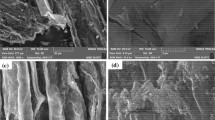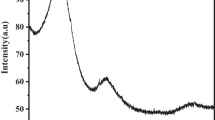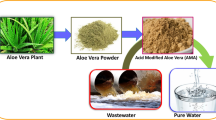Abstract
To clarify the sorption mechanism and removal efficiency of PAHs by waste biomass-based magnetic sorbents, the sorption performance of magnetic Myriophyllum aquaticum biomass (MMaB) for PAHs was studied. The structural characteristics and magnetic properties of MMaB were measured by FTIR, SEM–EDS, XRD and VSM. Batch experiments were carried out to evaluate the effects of contact time, initial concentration and properties of PAHs, pH, ionic strength and temperature on PAH sorption. The results showed that the sorption of seven PAHs achieved equilibrium at approximately 4–6 h, which fit well to the pseudo-second-order kinetic model. The isotherms followed the Freundlich model and linear model well, indicating that the sorption process was controlled by chemisorption. The distribution parameter (Kd) values were 91.3, 563.7, 1010.5, 2917.8, 2706.6, 9046.8 and 15969.0 L·kg−1 for naphthalene, acenaphthene, fluorene, phenanthrene, anthracene, pyrene, and fluoranthene on MMaB, respectively, following the order of their hydrophobicity (e.g., Kow). A positive correlation was obtained: logKd = 0.8091logKow + 1.7034. Water chemical properties such as pH and ionic strength had no obvious effect on PAH removal. The spontaneity, feasibility and exothermic properties of PAH removal by MMaB were explained from thermodynamic point of view. The as-prepared MMaB sorbent underwent four consecutive sorption cycles and had good cycling performance. These studies indicate that MMaB has great potential as an easily-prepared, easy-to-operate and efficient biosorbent to remove PAHs from wastewater.







Similar content being viewed by others
Data availability
The data used to support the findings of this study are available from the corresponding author upon request.
References
Abilio, T. E., Soares, B. C., Jose, J. C., et al. (2021). Hexavalent chromium removal from water: Adsorption properties of in natura and magnetic nanomodified sugarcane bagasse. Environmental Science and Pollution Research, 28, 24816–24829.
Acar, M. K., Altun, T., & Gubbuk, I. H. (2023). Synthesis and characterization of silver doped magnetic clay nanocomposite for environmental applications through effective RhB degradation. International Journal of Environmental Science and Technology, 20, 4219–4234.
Anushree, C., & Philip, J. (2019). Efficient removal of m ethylene blue dye using cellulose capped Fe3O4 nanofluids prepared using oxidation-precipitation method. Colloids and Surfaces A, 567, 193–204.
Balaji, A. N., & Nagarajan, K. J. (2017). Characterization of alkali treated and untreated new cellulosic fiber from Saharan aloe vera cactus leaves. Carbohydrate Polymers, 174, 200.
Balati, A., Shahbazi, A., Amini, M. M., et al. (2015). Adsorption of polycyclic aromatic hydrocarbons from wastewater by using silica-based organic-inorganic nanohybrid material. Journal of Water Reuse and Desalination, 5, 50–63.
Chen, B., Yuan, M., & Liu, H. (2011). Removal of polycyclic aromatic hydrocarbons from aqueous solution using plant residue materials as a biosorbent. Journal of Hazardous Materials, 188, 436–442.
Chen, Z., Chen, B., Zhou, D., et al. (2012). Bisolute sorption and thermodynamic behavior of organic pollutants to biomass-derived biochars at two pyrolytic temperatures. Environmental Science & Technology, 46, 12476–12483.
Dai, Y., Zhang, N., Xing, C., et al. (2019). The adsorption, regeneration and engineering applications of biochar for removal organic pollutants: A review. Chemosphere, 223, 12–27.
De Jesus, J. H. F., Cunha, G. D., Cardoso, E. M. C., et al. (2017). Evaluation of waste biomasses and their biochars for removal of polycyclic aromatic hydrocarbons. Journal of Environmental Management, 200, 186–195.
Degermenci, G. D., Degermenci, N., Ayvaoglu, V., et al. (2019). Adsorption of reactive dyes on lignocellulosic waste; characterization, equilibrium, kinetic and thermodynamic studies. Journal of Cleaner Production, 225, 1220–1229.
Esfandiar, N., Suri, R., & Mckenzie, E. R. (2021). Simultaneous removal of multiple polycyclic aromatic hydrocarbons (PAHs) from urban stormwater using low-cost agricultural/industrial byproducts as sorbents. Chemosphere, 274, 129812.
Faraji, M., Shirani, M., & Rashidi-Nodeh, H. (2021). The recent advances in magnetic sorbents and their applications. Trends in Analytical Chemistry, 141, 116302.
Geng, J., Gu, F., & Chang, J. (2019). Fabrication of magnetic lignosulfonate using ultrasonic-assisted in situ synthesis for efficient removal of Cr(VI) and Rhodamine B from wastewater. Journal of Hazardous Materials, 375, 174–181.
Ghosal, D., Ghosh, S., Dutta, T. K., et al. (2016). Current state of knowledge in microbial degradation of polycyclic aromatic hydrocarbons (PAHs): A review. Frontiers in Microbiology, 7, 1369.
Hung, H. W., Lin, T. F., & Chiou, C. T. (2010). Partition coefficients of organic contaminants with carbohydrates. Environmental Science & Technology, 44, 5430–5436.
Ilyas, M., Ahmad, W., & Khan, H. (2021). Utilization of activated carbon derived from waste plastic for decontamination of polycyclic aromatic hydrocarbons laden wastewater. Water Science and Technology, 84, 609–631.
Kabi, T., Hildebrandt, D., Liu, X. Y., et al. (2022). Adsorption of dibenzothiophene in model diesel fuel by amarula waste biomass as a low-cost adsorbent. Journal of Environmental Management, 309, 114598.
Kronenberg, M., Trably, E., Bernet, N., et al. (2017). Biodegradation of polycyclic aromatic hydrocarbons: Using microbial bioelectrochemical systems to overcome an impasse. Environmental Pollution, 231, 509–523.
Lee, S. M., & Tiwari, D. (2012). Organo and inorgano-organo-modified clays in the remediation of aqueous solutions: An overview. Applied Clay Science, 59–60, 84–102.
Li, G. X., Li, Q. S., Wang, L., et al. (2020). Cadmium tolerance and detoxification in Myriophyllum aquaticum: Physiological responses, chemical forms, and subcellular distribution. Environmental Science and Pollution Research, 27, 37733–37744.
Liu, L., Zhang, B., Zhang, Y., et al. (2015). Simultaneous removal of cationic and anionic dyes from environmental water using montmorillonite-pillared graphene oxide. Journal of Chemical and Engineering Data, 60, 1270–1278.
Liu, F., Zhang, S., Wang, Y., et al. (2016). Nitrogen removal and mass balance in newly-formed Myriophyllum aquaticum mesocosm during a single 28-day incubation with swine wastewater treatment. Journal of Environmental Management, 166, 596–604.
Liu, Q. Z., Xu, X., Lin, L. H., et al. (2021). Occurrence, distribution and ecological risk assessment of polycyclic aromatic hydrocarbons and their derivatives in the effluents of wastewater treatment plants. Science of the Total Environment, 789, 147911.
Luo, P., Tong, X., Liu, F., et al. (2020). Nutrients release and greenhouse gas emission during decomposition of Myriophyllum aquaticum in a sediment-water system. Environmental Pollution, 260, 114015.
Ozaki, N., Takamura, Y., Kojima, K., et al. (2015). Loading and removal of PAHs in a wastewater treatment plant in a separated sewer system. Water Research, 80, 337–345.
Perera, A. S., Zhang, S., Homer-Vanniasinkam, S., et al. (2018). Polymer-magnetic composite fibers for remote-controlled drug release. ACS Applied Materials & Interfaces, 10, 15524–15531.
Premnath, N., Mohanrasu, K., Rao, R. G. R., et al. (2021). A crucial review on polycyclic aromatic Hydrocarbons- Environmental occurrence and strategies for microbial degradation. Chemosphere, 280, 130608.
Qiao, M., Bai, Y., Cao, W., et al. (2018). Impact of secondary effluent from wastewater treatment plants on urban rivers: Polycyclic aromatic hydrocarbons and derivatives. Chemosphere, 211, 185–191.
Reddy, D. H. K., & Lee, S. M. (2014). Magnetic biochar composite: Facile synthesis, characterization, and application for heavy metal removal. Colloids and Surfaces A, 454, 96–103.
Sangon, S., Hunt, A. J., Attard, T. M., et al. (2018). Valorisation of waste rice straw for the production of highly effective carbon based adsorbents for dyes removal. Journal of Cleaner Production, 172, 1128–1139.
Saravanan, A., Karishma, S., Kumar, P. S., et al. (2021). Simultaneous removal of Cu(II) and reactive green 6 dye from wastewater using immobilized mixed fungal biomass and its recovery. Chemosphere, 271, 129519.
Sirajudheen, P., Karthikeyan, P., Ramkumar, K., et al. (2021). Magnetic carbon-biomass from the seeds of Moringa oleifera@MnFe2O4 composite as an effective and recyclable adsorbent for the removal of organic pollutants from water. Journal of Molecular Liquids, 327, 114829.
Sponza, D. T., & Oztekin, R. (2010). Destruction of some more and less hydrophobic PAHs and their toxicities in a petrochemical industry wastewater with sonication in Turkey. Bioresource Technology, 101, 8639–8648.
Sun, K., Jin, J., Keiluweit, M., Kleber, M., Wang, Z., Pan, Z., & Xing, B. J. B. T. (2012). Polar and aliphatic domains regulate sorption of phthalic acid esters (PAEs) to biochars. BioresoureTechnology, 118, 120–127.
Tongpoothorn, W., Sriuttha, M., Homchan, P., et al. (2011). Preparation of activated carbon derived from Jatropha curcas fruit shell by simple thermo-chemical activation and characterization of their physico-chemical properties. Chemical Engineering Research and Design, 89, 335–340.
Wang, S., Gao, B., Zimmerman, A. R., et al. (2015). Removal of arsenic by magnetic biochar prepared from pinewood and natural hematite. Bioresource Technology, 175, 391–395.
Werner, K., Pommer, L., & Brostrm, M. (2014). Thermal decomposition of hemicelluloses. Journal of Analytical and Applied Pyrolysis, 110, 130–137.
Wersal, R. M., & Madsen, J. D. (2011). Influences of water column nutrient loading on growth characteristics of the invasive aquatic macrophyte Myriophyllum aquaticum (Vell.) Verdc. Hydrobiologia, 665, 93–105.
Wu, B., Zhang, Y., Zhang, X. X., et al. (2011). Health risk assessment of polycyclic aromatic hydrocarbons in the source water and drinking water of China: Quantitative analysis based on published monitoring data. Science of the Total Environment, 410, 112–118.
Wu, W., Lan, Y., Zeng, Y., et al. (2020). Nonlinear sorption of phenols and anilines by organobentonites: Nonlinear partition and space limitation for partitioning. Science of the Total Environment, 736, 139609.
Xi, Z., & Chen, B. (2014a). Removal of polycyclic aromatic hydrocarbons from aqueous solution by raw and modified plant residue materials as biosorbents. Journal of Environmental Sciences, 26, 737–748.
Xi, Z., & Chen, B. (2014b). The effect of structural compositions on the biosorption of phenanthrene and pyrene by tea leaf residue fractions as model biosorbents. Environmental Science and Pollution Research, 21, 3318–3330.
Xia, L. J., Zhang, C. H., Wang, A. M., et al. (2020a). Morphologies and properties of Juncus effusus fiber after alkali treatment. Cellulose, 27, 1909–1920.
Xia, L., Zhou, S., Zhang, C., et al. (2020b). Environment-friendly Juncus effusus-based adsorbent with a three-dimensional network structure for highly efficient removal of dyes from wastewater. Journal of Cleaner Production, 259, 120812.
Xie, J., Lin, R., Liang, Z., et al. (2021). Effect of cations on the enhanced adsorption of cationic dye in Fe3O4-loaded biochar and mechanism. Journal of Environmental Chemical Engineering, 9, 105744.
Yao, X., Ji, L., Guo, J., et al. (2020). Magnetic activated biochar nanocomposites derived from wakame and its application in methylene blue adsorption. Bioresource Technology, 302, 122842.
Zhang, D., Zhu, L. Z., & Li, F. (2013a). Influences and mechanisms of surfactants on pyrene biodegradation based on interactions of surfactant with a Klebsiella oxytoca strain. Bioresource Technology, 142, 454–461.
Zhang, M., Gao, B., Varnoosfaderani, S., et al. (2013b). Preparation and characterization of a novel magnetic biochar for arsenic removal. Bioresource Technology, 130, 457–462.
Zhang, D., Lu, L., Zhao, H., et al. (2018). Application of Klebsiella oxytoca biomass in the biosorptive treatment of pah-bearing wastewater: Effect of PAH hydrophobicity and implications for prediction. Water, 10, 675.
Zhang, X. Y., Yu, T., Li, X., et al. (2019). The fate and enhanced removal of polycyclic aromatic hydrocarbons in wastewater and sludge treatment system: A review. Critical Reviews in Environment Science and Technology, 49, 1425–1475.
Zhao, B., Xu, X., Zhang, R., et al. (2021). Remediation of Cu(II) and its adsorption mechanism in aqueous system by novel magnetic biochar derived from co-pyrolysis of sewage sludge and biomass. Environmental Science and Pollution Research, 28, 16408–16419.
Zhou, Q., Gao, J., Zhang, R., et al. (2017). Ammonia stress on nitrogen metabolism in tolerant aquatic plant-Myriophyllum aquaticum. Ecotoxicology and Environmental Safety, 143, 102–110.
Zhou, S., Xia, L., Fu, Z., et al. (2021). Purification of dye-contaminated ethanol-water mixture using magnetic cellulose powders derived from agricultural waste biomass. Carbohydrate Polymers, 258, 117690.
Zhu, X., Liu, Y., Chao, Z., et al. (2014). Novel and high-performance magnetic carbon composite prepared from waste hydrochar for dye removal. ACS Sustainable Chem Eng, 2, 969–977.
Acknowledgements
This research was supported by the Zhejiang Provincial Natural Science Foundation of China under Grant No. LHY22E080005, and the National Natural Science Foundation of China (21878064).
Author information
Authors and Affiliations
Corresponding author
Ethics declarations
Conflicts of Interest
The authors declare that they have no known competing financial interests or personal relationships that could have appeared to influence the work reported in this paper.
Additional information
Publisher's Note
Springer Nature remains neutral with regard to jurisdictional claims in published maps and institutional affiliations.
Supplementary Information
Below is the link to the electronic supplementary material.
Rights and permissions
Springer Nature or its licensor (e.g. a society or other partner) holds exclusive rights to this article under a publishing agreement with the author(s) or other rightsholder(s); author self-archiving of the accepted manuscript version of this article is solely governed by the terms of such publishing agreement and applicable law.
About this article
Cite this article
Zhou, D., Zhang, D., Zhang, M. et al. Efficient Treatment of PAH-Contaminated Water Using Magnetic-Modified Myriophyllum aquaticum Waste Biomass. Water Air Soil Pollut 234, 459 (2023). https://doi.org/10.1007/s11270-023-06496-1
Received:
Accepted:
Published:
DOI: https://doi.org/10.1007/s11270-023-06496-1




